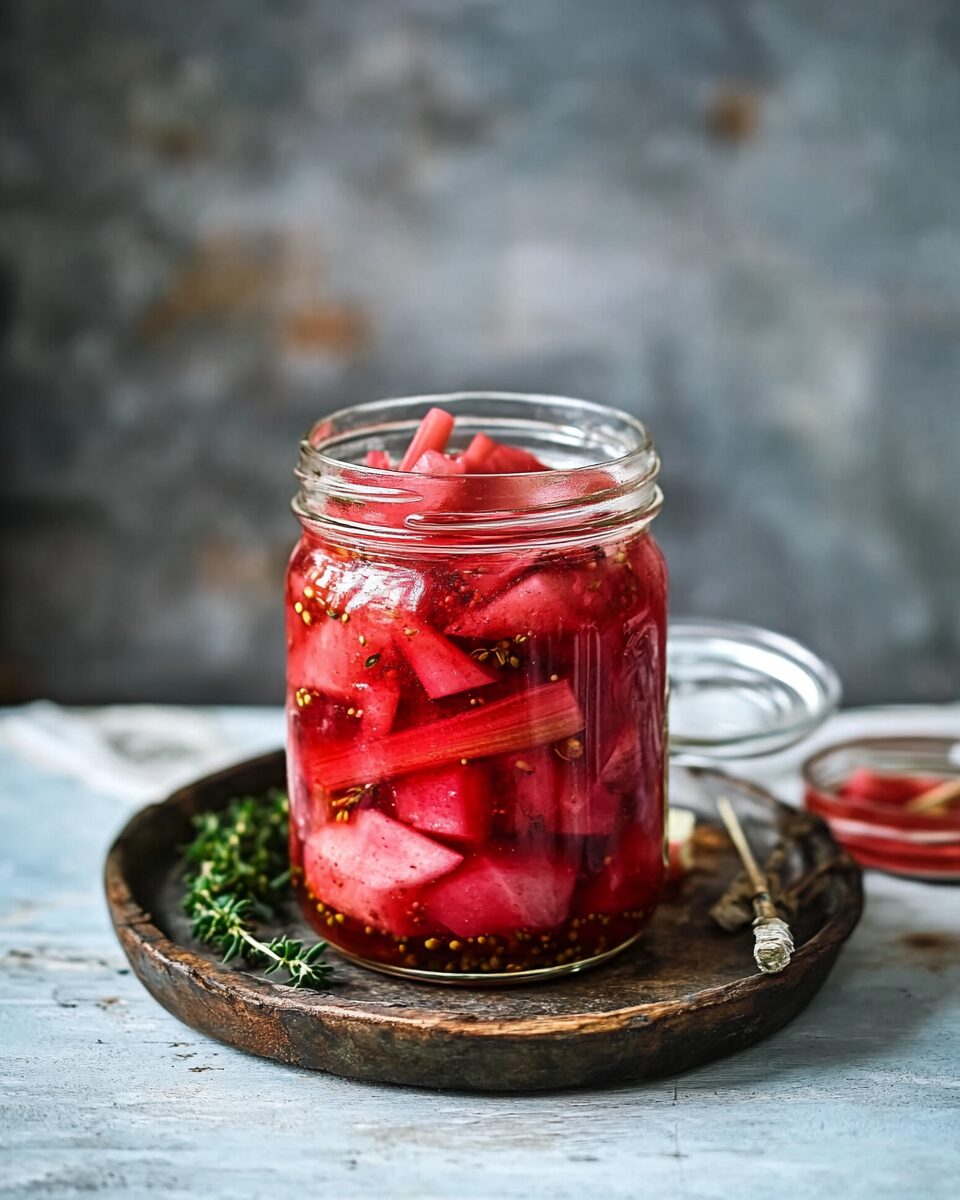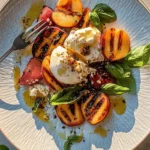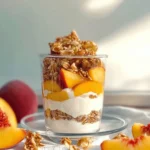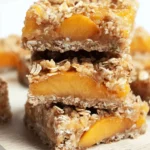Pickled rhubarb is a tangy, sweet, and slightly spiced condiment that adds a zesty bite to cheese boards, grilled meats, or sandwiches. This old-fashioned method preserves the bright flavor and crunch of fresh rhubarb in a simple brine, offering a unique twist to traditional pickling.
FULL RECIPE
Ingredients
- 4 cups fresh rhubarb, cut into ½-inch pieces
- 1 cup white vinegar
- 1 cup water
- ¾ cup granulated sugar
- 1 tablespoon pickling salt
- 1 teaspoon mustard seeds
- ½ teaspoon whole black peppercorns
- 1 cinnamon stick
- 3 whole cloves
Directions
- Rinse and cut rhubarb into uniform ½-inch pieces. Set aside.
- In a medium saucepan, combine vinegar, water, sugar, and salt. Heat over medium until the sugar and salt dissolve completely.
- Add mustard seeds, peppercorns, cinnamon stick, and cloves to the brine. Simmer for 2–3 minutes.
- Pack the rhubarb pieces tightly into sterilized glass jars, leaving about ½ inch of headspace.
- Carefully pour the hot brine over the rhubarb, making sure the spices are evenly distributed and the rhubarb is fully submerged.
- Seal the jars with lids and let cool to room temperature.
- Refrigerate for at least 24 hours before using. Flavor improves after several days.
Nutritional Information
- Calories: 25
- Carbohydrates: 6g
- Sugars: 5g
- Fat: 0g
- Protein: 0g
- Sodium: 150mg
- Fiber: 0.5g
History of Pickled Rhubarb
Pickled rhubarb has roots in traditional preservation methods dating back centuries. Before refrigeration, pickling was an essential way to extend the shelf life of seasonal produce. Rhubarb, which thrives in cooler climates, was commonly harvested in spring and early summer. Preserving it in vinegar brine allowed households to enjoy its tart flavor well beyond the growing season. This old-fashioned technique was passed down through generations, particularly in Northern Europe and North America, where rhubarb is a beloved garden staple.
Why Pickle Rhubarb?
Pickling transforms rhubarb from a soft, pie-filling ingredient into a crunchy, tangy condiment. The vinegar and spices balance the natural tartness of rhubarb, creating a complex flavor profile that complements many dishes. It also provides an easy way to add acidity and texture to meals, making it a versatile pantry item.
Choosing the Right Rhubarb
For pickling, fresh rhubarb should be firm, crisp, and brightly colored. Avoid stalks that are limp, bruised, or overly fibrous, as they will not hold up well during the pickling process. Thicker stalks can be cut into smaller pieces to ensure even pickling and better texture.
Vinegar Varieties and Their Impact
The type of vinegar used affects the flavor and color of the pickled rhubarb. White vinegar is most common for its neutral taste and clear color, but apple cider vinegar or rice vinegar can add unique fruity or mellow undertones. The acidity level of the vinegar is crucial for safety and preservation, so choosing a vinegar with at least 5% acidity is recommended.
The Role of Sugar in Pickling
Sugar balances the acidity of vinegar and softens the sharpness of rhubarb’s natural tartness. The amount of sugar can be adjusted based on personal preference for sweetness or tang. In traditional recipes, sugar also helps in creating a syrupy brine that coats the rhubarb well.
Common Spices Used
Mustard seeds, peppercorns, cinnamon sticks, and cloves are classic spices that add warmth and depth to pickled rhubarb. Each spice contributes subtle notes: mustard seeds offer a mild pungency, peppercorns add heat, cinnamon provides sweet woodiness, and cloves bring aromatic richness. These spices can be customized or omitted depending on the desired flavor.
Texture and Crunch in Pickled Rhubarb
One of the joys of pickled rhubarb is its crisp texture. The short pickling time and the firm nature of rhubarb stalks help retain crunchiness. Proper preparation and careful cooking of the brine without over-soaking the rhubarb are key to maintaining this texture.
Storage Tips
Pickled rhubarb should be stored in sterilized glass jars with airtight lids to prevent contamination. It keeps well in the refrigerator for up to several weeks. For longer storage, canning methods can be employed to preserve rhubarb at room temperature, but refrigeration is recommended for best flavor.
Serving Suggestions
Pickled rhubarb pairs beautifully with cheeses like sharp cheddar or creamy goat cheese. It also complements roasted or grilled meats such as pork, chicken, or lamb by adding acidity that cuts through rich flavors. Additionally, it can be used as a tangy topping for sandwiches, salads, or even as an ingredient in savory baked dishes.
Health Benefits of Rhubarb
Rhubarb is low in calories and rich in fiber, vitamins C and K, and antioxidants. While the pickling process alters some nutrients, it preserves rhubarb’s beneficial properties while enhancing digestibility. The vinegar used in pickling may also support digestion and blood sugar regulation.
Potential Allergies and Considerations
Although rhubarb is generally safe, some people may experience allergic reactions or sensitivity to oxalates found in rhubarb leaves (which are not used in recipes). It’s important to avoid leaves, as they contain toxic compounds. Individuals with kidney issues should also moderate their intake of rhubarb.
Variations on the Recipe
Many variations exist for pickled rhubarb depending on regional tastes and available ingredients. Some recipes add ginger, chili flakes, or garlic for extra heat and aroma. Others may substitute brown sugar for white or include additional herbs like dill or thyme to customize the flavor.
Cultural Significance
In some cultures, rhubarb holds symbolic meaning as a spring vegetable and is celebrated in local festivals. Pickling is seen as a way to honor the changing seasons and to connect with traditional culinary heritage, preserving more than just flavor but also memories and family history.
Pickled Rhubarb vs. Other Pickled Vegetables
Unlike cucumbers or beets, pickled rhubarb offers a unique tartness and fibrous crunch that stands out. Its distinctive flavor adds a refreshing twist to typical pickle assortments and can brighten a plate in ways other pickled vegetables cannot.
Using Leftover Pickling Brine
After pickling rhubarb, the leftover brine can be reused to pickle other vegetables or diluted to create tangy salad dressings and marinades. This practice reduces waste and allows the continuation of complex flavors in other dishes.
Seasonal Availability
Rhubarb is typically available fresh in spring and early summer. Pickling during this window ensures the best flavor and texture. Outside the season, frozen rhubarb can sometimes be used, but it may yield a softer final product.
Pairing Pickled Rhubarb with Beverages
The bright acidity of pickled rhubarb complements drinks like sparkling wine, dry white wine, or even a crisp beer. It can be served alongside cocktails to provide a flavorful contrast or used as a garnish in drinks for a tart twist.
Safety Tips for Pickling
Proper sanitation and acidity levels are crucial to prevent spoilage and foodborne illnesses. Using sterilized jars, maintaining the right vinegar concentration, and storing pickled rhubarb in the refrigerator are essential safety practices.
Economic Benefits
Making pickled rhubarb at home is cost-effective, allowing people to preserve an abundant harvest or buy fresh stalks in bulk. It also reduces food waste by extending the life of seasonal produce and avoiding the need to purchase expensive specialty condiments.
Sustainability and Environmental Impact
Homemade pickling uses minimal packaging compared to store-bought products, reducing plastic waste. Growing rhubarb at home or sourcing locally supports sustainable agriculture. Pickling is a way to make use of excess produce, aligning with eco-friendly food practices.
Conclusion
Pickled rhubarb is a delightful and versatile condiment with deep historical roots and a unique flavor profile. Its blend of tartness, spice, and crunch makes it a standout addition to many dishes, from cheese platters to roasted meats. Beyond its taste, pickled rhubarb embodies traditional preservation methods that celebrate seasonality and sustainability. Whether you are a seasoned pickler or new to this culinary art, experimenting with pickled rhubarb offers a rewarding way to enhance your meals and connect with food heritage. With its health benefits, flexibility in use, and ease of preparation, pickled rhubarb remains a timeless classic worth keeping in your kitchen.






